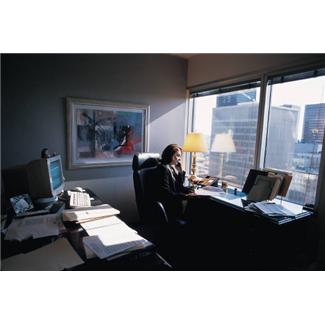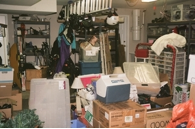
The kitchen counter is a magnet for clutter. It’s the same routine everyday: set mail on the counter; pull out recipe card for chicken cacciatore; jot down telephone messages; flip through new magazine, clip a few coupons. After doing all of that, the kitchen counter is a mess and the disorder only grows with each passing day. Where is the electricity bill that’s now three days overdue? Did you read the letter from your pen pal in Peru?
Finally, gain back your peace of mind with Paper Tiger Filing System Software and Document Management. Not only can Paper Tiger help make your countertops visible again, but also neat and organized! Here are three ways Paper Tiger can help you minimize clutter in your kitchen.
Open Mail - It’s a hard habit to break, setting the mail down without looking at it upon arriving home. How can we organize with Paper Tiger if we don’t know what we have? Open the mail as soon as you get home. Junk mail? Trash it! With Paper Tiger’s easy database and locations, important documents or keepsakes received in the mail can always be easily filed and found. Paper Tiger’s indexing system allows you to conveniently file paper in its original form; no scanning is required! Set a location for your hanging files and in Paper Tiger, index your paper files using keywords for important documents, from your medical, tax or education records. Keywords remove the hassle of naming a document and trying to remember it. Find your documents with ease through Paper Tiger’s effortless search box!
Sort Through Bills – How many times have you racked up late fees on a bill that you couldn’t find? It has been said that 23% of adults pay bills late and incur fees due to lost statements. Are you a part of that statistic? It’s very easy for bills and monthly payments to slip through the cracks. Of course, Paper Tiger won’t pay your bills for you, but with a little bit of work on your part, Paper Tiger can help your pennies add up. Sort through bills and figure out which ones need to be paid immediately and which ones aren’t as pressing. You may even have an “Urgent” location in Paper Tiger to help you deal with bills that aren’t quite ready to be permanently put away. The “Action Date” feature will assist you with time-management. Watch late fees disappear as Paper Tiger helps clear clutter simply by having a place to file your papers and a system to be able to actually find them again. Finding past statements will never prove impossible again!
Shelve Cookbooks and Magazines – Cookbooks and magazines are great to look at, but they deserve a home. We already know that Paper Tiger is not just for paper filing and document management. Cookbooks can take up quite a bit of space and cause disorder. Use Paper Tiger to number the spine of each book and choose a location for quick reference. Keywords can help you find different cuisines. Recipe cards can also be easily organized. Classify the similar recipes together and choose a location for them. Again, use keywords to help you easily find various recipes. Panang Curry tonight and Homemade Lasagna tomorrow is an easy feat.
Can you remember the last time you were able to sit and enjoy a whole magazine? Maybe you prefer to clip tidbits out the magazine that you find interesting, or maybe you like to tuck away the book for further reading. Whatever your preference, Paper Tiger can make sure magazines aren’t on your kitchen counter, but put away for your leisure when suitable. Index the entire magazine using the straightforward labels or index your clippings in hanging file folders.
Utilizing Paper Tiger paper filing system software in just these few ways will have your countertops cleaner. Of course, there are other things on the counter, but minimizing paper is a gradual process. Follow these few tips as a start and Paper Tiger will have your entire home organized before long.

During this webinar, Anne discussed the basic concept of Paper Tiger to organize both paper files and other physical items of which you need to keep track so that you can find them when you need them, and the concept of Digital Tiger, powered by Google Docs to organize and find your digital files. She demonstrated how to use Digital Tiger more effectively for digital filing, in addition to the following to show how to use Paper Tiger with Digital Tiger, so you can get organized and be more productive.
Find Anything In Your Office In 5 Seconds or Less…Guaranteed! Watch the webinar to learn more.
As information, Anne is a professional speaker, productivity expert, professional organizer and author. If you want to learn more about Anne and her services, please visit her website at www.StrategizeAndOrganize.com.
She may be in Colorado (and sometimes in Arizona!), but she’s nationally recognized as an expert and works with people throughout the US in person and virtually.
You can contact Anne at amcgurty@strategizeandorganize.com or by phone at 303 881-0174.
See more information here on Paper Tiger Filing System Software for Document Management
Q: I am very interested in reducing the amount of papers to be filed or that perhaps are not needed at all. What papers are critical to keep, even after scanning them?
A: We have several blog articles under our Category of “Retention Guidelines: How Long Should You Keep Records”
Q: I want help with useful item and category names.
A: See this blog post which contains suggestions for Location names, Item names, as well as Categories: “Customize Your Filing System with Paper Tiger’s Indexing Method.” Hopefully this will be helpful to you.
Q: How do I switch over from the old version and is it hard?
A: After creating your Paper Tiger Online account (Pro or one of the multi-user plans), email support@thepapertiger.com, attach your database(s) and let them know that you need it imported to your online account under which email.
Prior to sending your database, make sure all pending items have been confirmed by clicking the Confirm box, and empty the Trash for each database. Then export your database(s) to .CSV file(s) by following the instructions below for all databases if you have more than one database. To export a Paper Tiger CSV file from Paper Tiger 4:
1. Open Paper Tiger and the appropriate database.
2. From the File menu, select Export.
3. Check the Select All box.
4. Click the Browse button to select the preferred directory so that you will know where the file will be saved to and type in a file name for the CSV file, click the Save or Open button
5. Then attach the .CSV file to your email that you’re sending to our tech support team
Q: What is the difference between paper search to digital search?
A: Paper Tiger searches your paper files that you’ve indexed into Paper Tiger, and the Digital Tiger function allows you to also search your digital files that you have in Google Drive. Digital Tiger is a free add-on with a paid Paper Tiger Online account (Basic and Pro plans for now and then later for multi-users), to connect your Paper Tiger Online account to your Google Drive account, then you will be able to search from one place (Paper Tiger) to find both your paper/physical items that you’ve indexed into Paper Tiger and your digital files that you have in Google Drive. Since Google Drive in this case would be your digital file storage location, you can prepare for Digital Tiger by creating, scanning or uploading your digital files to Google Drive. Again, Paper Tiger is for indexing the paper files that you need to keep in hard copy format and other items, such as passports, instruction booklets, or CDs, DVDs, Books, home or office inventory and/or storage, etc.
Q: Is there a mobile app for Paper Tiger?
A: No we do not have a mobile app for Paper Tiger, but it works well on the iPad and other tablets.
Q: I would like to organize my jewelry, and I have a lot! What do you think the best way would be to do so? I did purchase clear-lidded jewelry boxes and have also taken the photos! I was trying to figure out about the photos. I am thinking of also putting info to Google Doc’s so that I don’t have to store all this information in a drawer.
A: We recommend arranging your jewelry so that you can number each piece, then index each piece in Paper Tiger matching item numbers as you go. You can photograph your jewelry with corresponding numbers, and upload the pictures to Google Drive. Be sure to put keywords in the title of each photo that you upload.
Comment: I love the fact that you have “loaned to Frances” under your keywords for your books. It is way too easy for me to not get borrowed books returned to me. Using your method would help me put a stop to this.
A: Awesome!
With the stress of everyday, trying to keep up with all the activity around us, whether it be play or business, try to follow at least one of these tips in the next month to help you declutter. This guest post by Jana Bain of HomeInsurance.org is a great start in de-cluttering your home. From kitchen to bath, from closets to garage, doing a little at a time from each section of your home, will make a big difference in how you feel. Clutter can sometimes make us feel so overwhelmed.
Depending on the level of clutter you have, you might not want to tackle the biggest job first, but start small and work your way through.
Make a list that you want to accomplish, then schedule one job on your list each month. Before you know it, you’ll be feeling better with less clutter and you’ll be saving time because you can find things again.
You’ll note below that we’ve inserted some Paper Tiger Filing System software tips that will also help you find things when you need them.

It has been said that one person’s trash is another person’s treasure, but how much “treasure” can our homes hold? Over time, keepsakes and everyday items accumulate and become clutter, taking up valuable living space. Nineteenth-century philosopher Henry David Thoreau has urged us to “simplify, simplify,” and failure to do so when it comes to home organization will eventually result in living environments reminiscent of what you may see on an episode of Hoarders: Buried Alive. The de-cluttering process may be a daunting task, but think about the time you could save by organizing your home. Here are eight surefire ways (according to each room in your home) to help you manage and refresh space effectively.
There are countless items in the kitchen we have collected through the years that end up not being used at all. If you’re not sure what you use and what you don’t, a true way to find out is to gather all utensils and cooking gadgets into a cardboard box. For one or two months, put all the items you have used into a drawer. All the items that remain in that initial cardboard box are underutilized and you’ll have to reevaluate if you should hang onto them, or pass them along to charity. Sure, there are those items we use once in a blue moon for baking or for a specific purpose, and those items should be stored away, making room for things that are used more often.
For longer-term storage, this is the perfect place to store those seasonal items, such as sporting equipment and holiday décor. A common mistake is that people store these items with no consideration to organization or labels, which makes it more difficult to sort through when you do decide to utilize these items. Labeling boxes, bins, and containers so that items can be instantly located is a great way to keep things in their place rather than having random stuff pile up.
[You can use Paper Tiger to index the items that you place in the boxes or bins. When labeling the containers, label them to coincide with the item number from Paper Tiger. Anyone in your home can search Paper Tiger's database when they need to find something, and know exactly which container the item can be found in. In addition, you'll know where the item should be placed when it needs to be put away because it has a home of its own!]
Some of us have stocked up medicine cabinets with plenty of personal care products but this isn’t always a good thing. All personal care products and medicines have an expiration date, which should be purged once in a while. A good rule of thumb is that most makeup goes bad after six months; the closer the product is used to the eyes, the shorter the lifespan. Go through all your vanity products and medicines and get rid of those products that have hardened, softened, changed colors, or expired.
A common culprit of cluttered home offices is massive buildups of paperwork. If you are uncomfortable with discarding or shredding some past paid bills, or need to keep them for your records, make sure they are organized and take up little space. For example, filing away documents in expanding files, or investing in a digital scanner and filing system, is a great way to transform paper documents into a more accessible electronic form. Twelve-month expanding files are also very useful when it comes to deciding which bill receipt you should throw or shred. When you pay for bills, like say in January, place them in the January section for a year later. If you haven’t even looked at the document, you probably don’t need it.
[You can use Paper Tiger to index the paper files that you need to keep in hard copy format. How many files do you have that you just really don't know what to name it? No problem with Paper Tiger because you can add as many keywords into the database as relates to the documents you have in any file folder! When labeling your hanging file folders, you would label them to coincide with the item number from Paper Tiger. Type in the database an item name and any keywords that you want to, then drop the documents into the corresponding file folder. Anyone in your home can search Paper Tiger's database when they need to find a document, and know exactly which which hanging file folder it can be found in. Again, you'll know where the item should be placed when it needs to be returned to file because it has a home of its own! You also won't have to worry about duplicating a file]
You probably own a lot of clothes you never wear, or no longer have use for. Use this system to determine which clothes you should toss or donate: for six months or so, turn all the clothes in your closet facing back-to-front. When you wear an item, return it to the closet with the hanger facing the right way. If you try it on but don’t end up wearing it; make sure you put it back with the hanger still facing backwards. Chances are, you’re going to discover you own lots of clothes you don’t wear often or at all. Store away clothes you wear on rare occasions, or donate them. It’s better that someone else finds use for them.
Excess movies, books, and old gaming systems tend to sit and gather dust. We keep certain items because of the sentimental value, so here’s a surefire way to compromise, using the ratio-reduction rule of thumb. For every four or five items or old DVDs you decide to keep, remove one you could do without. This sort-and-purge process seems to work well if you can increase the ration to, say, three-to-one, which will really clear up some space for new possessions. This goes for old magazines, knickknacks, and toys.
Rooms frequented by little kids are typically clutter-intense zones, but you can help them keep toys and play items organized by designating some “clear zones.” Sort items and store according to a specific activity like painting, reading, and studying, with labels for each area of use. When you involve your kids in this sorting process, they will be able to identify and keep up with where everything should go in the future.
[In the same way that you can label boxes or bins in your garage, you can use Paper Tiger to index your movies, books, paints or other hobby items and label the containers for each to coincide with the item number from Paper Tiger. You'll always know where to find "Star Wars Episode V The Empire Strikes Back" and where to return it when you've watch it again!]
We all have that cabinet or closet for our cleaning supplies, dusting items, and general disinfectants, but if they’re all piled up, it’s hard to tell which products are old or for what use. You can sort out all your cleaning products by using vertical space for storage, leaving more floor space. A good shelving system should do the trick to help stow the items you use on a regular basis. Keep in mind that just because you have space, it doesn’t mean you should overcrowd it.
See the following blog articles for specific examples in how Paper Tiger Filing System Software can help you declutter and organize your home!
Stephanie Calahan, of Calahan Solutions and a Paper Tiger Expert shares 3 great tips in this article to eliminate the avalanche of paper piles. Be sure to watch the video she mentions later in this article to help you create an action system that works for you!
Stephanie recognizes, as we do, that different people need different tools to help with their daily lives, including Paper Tiger Filing System and Document Management Software, which she recommends based on her clients’ needs and the way that they work. She understands that every person is different and requires systems that work for them.

Your desktop, and frankly any other horizontal surface, are the hardest places to keep clear of paper. Bills to pay, to-do lists, event invites, magazines you have been meaning to read, orders you need to fill, and the list goes on and on.
Often, we keep things “out” – either spread around or stacked – on our desk and other surfaces because we don’t want to forget to do something that we have deemed important or don’t want to forget.
Today I’ll share 3 tricks that have worked for me and my clients.
Rather than thinking of your papers in terms of a topic or a list of things that you need to do, think in terms of “next action.” You may have many things that ultimately need to happen with a particular piece of paper, but by only thinking of the next action, you can eliminate overwhelm and process your paper faster. (If there is no action necessary, skip to trick #3)
Once you have determined the next action, either write it directly on the paper, or attach a sticky note to the page with the next action you need to take. If you know the information, also write down how and when you will best perform that action. By writing down the action you need to take, you will save yourself loads of time later when you pick up the paper again! Why rethink about an action over and over when you can decide once and move on?
Example: I was working with a client the other day and we were going through his paper work. He picked up a piece of paper that contained a name and phone number of a contact. He told me that his next action was to make a phone call to that person for a project they were working on together. I then asked him if he had everything he needed to make the call successful. No. He didn’t. He had to do some quick research first. So, the next action was not the phone call, it was the research.
When you have action items, it is OK to mix various project or topics as long as they are organized by the type of action you need to take.
Create an Action System! Action Systems come in a number of different forms. One way is to label file folders with each Verb and store your papers in those file folders on your desk in a vertical file holder (the graduated kind where you can see all of the file tabs is best) or you could use the Pendaflex PileSmart Organizer. This way, the items are stored in an orderly fashion until you make time to take action. You might have something like this:
– Call
– Write
– Review/Decide
– Pay
For a detailed look at how that might work for you, check out the video I did on YouTube a while back – Creating an Action Filing System for the Way You Work.
The Action System is great to keep things looking neat, but you must actually open the folders and take action to get the full benefit! By taking action by verb or type of action, you will eliminate multi-tasking, save time and increase concentration. If possible, it is best to empty each folder in one sitting. Once you have completed the action, ask “What is the next action?” and file accordingly.
Example: The paper my client had identified with the contact and phone number originally went into a “Research” folder. Once he had completed the research, he added that information to the paper and moved the page from “Research” to the “Call” folder. When the call was complete, he would either toss the paper, or file it into permanent reference or assign it a new action based on the results of the call.
Sometimes we keep papers on our desk because there is information that we want easily accessible but there really isn’t an action needed. Start by making sure that the information really is needed for quick reference. If you don’t need the information on at least a weekly basis, file it away in your permanent reference files.
The fastest way to create a quick reference system is to get a 1 – 1 1/2 inch binder and a numbered tab system. Either 3-hole punch each page or put them in sheet protectors. Each topic gets its own number. At the front of the binder, have an index to tell you what each number represents. You might have something like this:
1 — Emergency Contacts
2 — Service Providers
3 — Passwords
4 — Product Codes
and so on.
Once you have your Action System and Quick Reference system in place, it is a matter of consistently asking yourself “what is the next action” and then processing the paper. These small decisions will help you keep the paper piles under control and eliminate avalanche concerns. Before you know it, you will be getting things done rather than pushing papers around your desk!
If you would like help getting all of your paper piles figured out and systems put in place that match the way you think and work, let’s talk!
To your success!
About the Author:
Stephanie Calahan is The Business Vision Catalyst and founder of Calahan Solutions, Inc. She works with purpose-driven entrepreneurs, visionaries, coaches, consultants, health practitioners, authors, speakers and all sorts of remarkable service professionals who are experts in their field, to help them embrace their brilliance, leverage their business and get their message out with power, ease and joy; so that they can make a powerfully positive difference in the world, exponentially grow their income and enjoy a highly-successful and meaningful business… while working less. Learn how you can have more freedom in your life! http://www.StephanieCalahan.com

Meggin McIntosh, is “The Ph.D. of Productivity”™ and a Paper Tiger Expert. She will help you better understand Paper Tiger Filing System Software for document management to be able to use the software more effectively and see how you can get organized in every area of your life — not just paper filing! Meggin has been able to file & find paper files, notebooks, boxes, and lots more for over 13 years.
Click here to see a pre-recorded class Meggin taught where she shows how she has used Paper Tiger for over 13 years.
About Meggin McIntosh
Meggin McIntosh, Ph.D., “The Ph.D. of Productivity”(tm). Through her company, Emphasis on Excellence, Inc., Meggin McIntosh supports smart people who want to be more productive so that they can consistently keep their emphasis on excellence.
Phone: 775.853.5510
And to keep moving forward on your goals for more peaceful productivity, join others (worldwide) who receive Meggin’s weekly emails, and see what is available for download at no cost at any of MEGGIN’S WEBSITES:
http://meggin.com (Primary site)
http://GetaPlanGuides.com
http://KeepingChaosatBay.com
http://TopTenProductivityTips.com
http://JustWhelmed.com
http://OwningWordsforLiteracy.com
http://PumpernickelPublishing.com
http://StayingPositiveinaFreakedOutWorld.com
http://LifeofEs.com
Twitter • www.twitter.com/MegginMcIntosh

Are you still using an alphabetical method paper filing system? Or maybe you’re using the ‘stack’ method? If you are, you may be wasting a whole lot of time when you could use a file indexing system to find any file you need in seconds and be more productive. You can make your employees’ jobs, and your own, a whole lot easier by implementing Paper Tiger Filing System Software. This is going to make it a whole lot easier for you and your employees to find files quickly when they need them, and they won’t be wasting any time sifting through stacks of paper files.
Just think of how much time can be saved, how this time can be used more productively and, in the long run, you are going to be saving money.
You may wonder how this is going to save you money. Think about it for a minute. When you or your employees are busy searching for files, they are not really getting anything done. This means that some work will either get behind or employees will have to work overtime to get everything done. Either way, it is going to cost you money. Having a digital filing system is going to be a great time saving tool for your business and make things a lot easier for you and your employees when it comes to finding files, especially if they are needed in a hurry.
At one time, there was no such thing as computers in offices, and the best solution was the alphabetical method for paper filing systems. Many offices still use the alphabetical filing system, which is fine, but remember when you need to find something in a hurry, you may find yourself wading through a pile of papers just to find one little file. Today, almost everyone has a computer, and with Paper Tiger, the ability to index your paper files so you don’t have to rely on your memory or someone else’s memory of what name specific files were placed under. This means that you will be able to find any file you want in a matter of seconds, without having to go through all those paper files.
Since Paper Tiger doesn’t require scanning, you can index the paper files that you need to keep in hard copy format. With the Digital Tiger function in the Basic and Pro plans of Paper Tiger Online filing system software, you can keep your original paper files and index them into Paper Tiger, and also scan what you need in digital file format and upload to Google Docs, so you always have them digitally and physically, and so you won’t need to reprint them when you need them. When you need to find the document, conduct a search with the Digital Tiger function turned on, and Paper Tiger Online will return search results where you can find both the digital file and the paper file.
Paper Tiger solves problems with filing or finding any physical item, such as:
You can make things so much easier in your office by implementing a digital filing system. All of your files can be put into this type of system, including your personal files if you want. You and your employees will find it much easier, and faster, to locate any file when it is needed, which is going to save your company time and money. Of course, this is the ultimate goal for any business owner, and having the ability to retrieve the file you need quickly with Paper Tiger Filing System Software can help you achieve it.
This video by Natalie Conrad of Organized Habits, and a Paper Tiger Expert, is a great demonstration of how she uses her favorite scanner – the ScanSnap 1500, which is what we at Paper Tiger recommend as well! It is a great scanner. You can also view our demonstration of the ScanSnap 1500 on our Training page under the section entitled What is Digital Tiger?
Natalie also recommends Paper Tiger Filing System Software for Document Management to get everything in your life organized — it’s not just for filing paper!

Most of my clients have challenges and frustrations with paper at work and at home. One very helpful tool to own is a scanner, whether or not you want to go “paperless” (is there such a thing?). Gone are the days when having a flat bed scanner or even an all-in-one printer will suffice for scanning needs. We desire a tool that uses little effort and produces fast results… or let’s face it – we won’t scan things. Here’s a video I did to show you how my favorite scanner, the Fujitsu ScanSnap works.
Caution: Watching this video may cause you to spend money.. on a scanner!
Natalie Conrad is an organization consultant, speaker, and author in Northern California. She is also the founder of Organized Habits, a premier organizing firm, serving national and local clients in homes and small business settings. She is passionate about organizing as she believes that the clutter holds one back from pursing their life long goals and dreams. Visit Natalie’s blog for more articles like this by going to www.OrganizedHabits.com/blog
Sherry Borsheim, a Paper Tiger Expert of Simply Productive, provides a list of things to look for in file cabinets and tips to setting up your filing system to get organized, stay organized and be more productive!
Also check out Sherry’s Organizing Bootcamps that will give you a JUMP-START on ORGANIZING your office, home and life. She will give you her trade secrets and steps to setting up your organizing systems, including recommending Paper Tiger filing system software for document management, to be organized and manage the paper files that you need to keep in hard copy format and other physical stuff in your life.

Most offices and homes still have a lot of paper. Going completely paperless is not for everyone, and there are some papers you must keep in original format. Papers can often pile up because your filing cabinet or file system doesn’t function properly. Poorly functional, inexpensive file cabinets can cause more frustration and stress, and stop you from filing altogether.
Before you buy, build or set up a new filing system or file drawers, assess your current filing cabinet requirements. Including how easy it is to retrieve and file away your papers. Review my top tips that you must know before you buy your next filing cabinet or build filing drawers in your kitchen or home office.
When your file drawers and filing cabinets are not functioning properly, you are less likely to use them, and papers will pile up.
The next time you are looking at a file cabinet, designing a file drawer, or buying a container to store your filing system in, ensure it is easy to use and retrieve papers from, well made, highly functional and fit in with the design of your office or home.
To reduce back strain and the twisting motion when you are sitting at your desk chair and reach for a file set up your files facing towards you. Not all file drawers will accommodate this, but you can buy “front to back” file bars for many filing cabinets that allow you to switch your files so they face you when you open a lateral file drawer.
Also, if you have a desk drawer, see if you can turn the files so they face you when you open the drawer while sitting at your chair. These two ergonomic tips make a huge difference for ease of use and reduce strain on your back and shoulders.

Spruce up your drab file cabinet with wallpaper that inspires you and fits into your décor. Casey Green at Fossil and Design Sponge shows you step-by-step how simple and fun Casey’s wallpaper do-it-yourself file drawers project is!
You can purchase hanging file frames from Staples that will fit securely inside most file drawers. You may need to cut the file frame down to fit your drawer. It’s a bit of a workout doing this and requires some muscle. Personally I use a hack saw with a blade for sawing metal. Wire cutters are not strong enough.
If the file frame is too large or doesn’t fit, then the next option is to buy hanging file containers like the picture here. You can drop several of these inside the file drawer so you can use hanging files or file folders and they stay in place without flopping around.
A product like Goo Gone or rubbing alcohol will remove stickers from metal file cabinets and will clean them up so they look attractive again. Always test the product first in an area that won’t show.
~~~~~~~~~~~~~~~~~~~~~~~~~~~~~~~~~~~~~~~
Original article posted at http://www.simplyproductive.com/2012/07/filing-cabinet-must-know-tips-to-stay-organized-productive/?utm_source=dlvr.it&utm_medium=linkedin
Sherry Borsheim is the president of Simply Productive. You can visit Sherry, access her free article archive and grab lots of free stuff at http://www.simplyproductive.com. Sherry lives in Vancouver, BC Canada with her husband (her high-school sweetheart).
Printed with permission.
~~~~~~~~~~~~~~~~~~~~~~~~~~~~~~~~~~~~~~~
CALL TODAY! Contact productivity expert, Anne McGurty of Strategize and Organize, to schedule a strategize and organize analysis of your situation.
Are you managing both paper and digital files? Feeling stressed?
How do you bridge the paper world to the digital world?
~~~~~~~~~~~~~~
The car industry got it right…it’s no longer a gas or electric decision — it’s both – a hybrid.
With your paper files and digital files, you need a hybrid as well. The solution is Paper Tiger Filing System Software for Document Management with its new addition of Digital Tiger.
Imagine
Why make the transition alone … it’s not a tactical project that you can piece-meal … you need a strategic solution to be in the hybrid world.
All you need to do right now is the make the decision to spend 30 minutes with Anne McGurty, productivity expert, to strategize and organize and engage in a getting started analysis.
Call 303 881-0174 or email at amcgurty@strategizeandorganize.com today to get on Anne’s schedule!
In the article below, Anne McGurty, a Paper Tiger Expert of Strategize and Organize, relays a story about a jeweler who purchased more hoop earrings because he didn’t remember that he already had more than he needed simply because he didn’t have, nor did he think he needed, an inventory. Are you wasting time and money repurchasing things you already have or recreating documents you already have? Do you think it’s a waste of time to get organized? Read on to see how a small investment in time implementing Paper Tiger Filing System Software can help you save time and money!

In my last webinar I presented for The Monticello Corporation, demonstrating how to use Paper Tiger, someone followed up with me as they related to a story that I told and I thought if it helped one person on the call, maybe one of my readers here would appreciate the story as well.
Years ago, I had a jewelry company. I used to go to New Mexico and buy American Indian made jewelry right from the Navajo, Zuni, and Hopi Indian tribes. I loved working with the artists and then going to all the retail stores throughout the country to peddle my collection.
One day I was in a “mom and pop” touristy type store in Glenwood Springs, Colorado. It was a cute little place and a little old man came out and welcomed me. I looked around the store and it was quaint with old jewelry cases, jewelry displayed in no specific order, and trinkets randomly displayed throughout the store.
As I looked through the jewelry, I noticed there were no sterling silver hoops and I had some simple basic ones in my inventory in the car, so it was a perfect lead to ask him if he needed to purchase any. He seemingly agreed based on what he could also see in the case, so he agreed to look at what I had and purchased not only some silver hoop earrings, but also a nice selection of other shiny new pieces. I was appreciative and went on my way.
A couple of months later, I returned and he had an abundance of silver hoop earrings. I thought, darn, someone else must of been in to see him and he purchased more from that wholesaler. He welcomed me and had a funny grin on him as he told me that after he purchased all the silver hoops from me, his wife told him that they had plenty of silver hoops, as they were in another case in another location of his store and there were even more in the back room safe. I asked him about how he was tracking his inventory and he laughed and said, he didn’t bother with an inventory, he knew what he had. Well, you know I didn’t respond, because as the story shows, he spent money on something he really didn’t need because he didn’t know he had it.
I tell this story to my clients often because this is true also for our business and personal files. If we don’t know what we have, it can cost us money. Recently while I’m spending time in Scottsdale, Arizona, I needed to go to the motor vehicle division. One of the records I needed was the title to my car. Now that could have been quite an ordeal as I have files both in Denver, Colorado, and in Scottsdale, Arizona. Fortunately, all of my files are inventoried in Paper Tiger, and I was able to look it up off my web-based version from my smart phone and know exactly where to find my title.
Knowing where to find my title so quickly and easily, gave me instant relief knowing that I didn’t have to pursue the project, taking more time and spending extra money to order a copy of my title. I was able to get my hands on it right away. Naturally, it makes sense that when you want to take care of business, you don’t want to have delays.
If you are like the jewelry store owner and don’t have an inventory of your stuff, whether it’s paper files, digital files, or supplies, obviously you may be wasting time and money repurchasing things you already have or recreating documents you already have.
Are you ready now to get to work and inventory your paper and digital files? Here’s the link to get started with Paper Tiger Filing System Software.
If you want some additional help, I work with clients over the phone or in person and coach them to completely set up a customized system to get organized and work more productive.
About Anne:
Anne McGurty is CEO of Strategize & Organize, a company devoted to training individual’s to be more effective with the tools and resources to be productive in their work environment.
If you like this issue, you’ll love Anne’s transforming productivity training and organizing products to help you organize your business — and yourself — ranging from productivity consulting for individuals and executives to small business coaching programs to keynote speaking and corporate training programs to improve efficiencies in the workplace and improve productivity.
While Anne is best known for her expertise in productivity and expert office organizing, her clients share that her biggest impact comes from her philosophy of “personalizing her programs to fit the needs of her clients so they can streamline more efficiently with existing processes” – ensuring to create a sustainable work environment. This, Anne says, is the most important key to bringing an individual to personal freedom with time and organization.
You can learn more about Anne at www.StrategizeAndOrganize.com.

During this webinar, Nancy Hagan of Effective Day demonstrated how to get started with Paper Tiger Online. In addition to demonstrating examples requested during webinar registrations, Nancy demonstrated work-flow examples by filing items from her inbox to help you use Paper Tiger more effectively to get organized and be more productive.
Nancy also presented how to organize things other than paper files, such as books and storage boxes. And later in the presentation, she talked about how to use a tickler (monthly/daily) filing system to organize your action file.
Please visit www.effectiveday.com to learn more about Nancy and the services she provides, and click here see her Productivity Coaching special. You can contact Nancy at 513 899-9949 or email at nancy@effectiveday.com
To learn more about Paper Tiger and Digital Tiger, visit www.thepapertiger.com
Q: How do you share the location of items with your staff when necessary or how do you set it up from the beginning that way?
A: If you have a multi-user plan, after you have created your database and locations, you can click on the People/Permissions tab from the Dashboard, then invite users via their email and set their permissions as to what they view and/or edit. You can see multi-user articles at http://www.thepapertiger.com/support/view_articles.php?forum_id=220848&catId=230 that you might find helpful.
Q: How do I print the Reference location?
A: See this knowledge base article that gives instructions on how to print labels for your locations within your database: http://thepapertiger.com/support/articles.php?id=198696&catId=230 and Nancy also demonstrates printing labels in this webinar.
Q: Could you set up a database that would store your books — physical library?
A: Here is a blog post also that you might find helpful that gives more examples of how to index different items: http://www.thepapertiger.com/blog/filing-system-family/
Nancy Hagan of Effective Day, works with business people who want to be more effective and productive, focus on their highest priorities and be free to do what they do best! Effective Day provides Organizing and Productivity Coaching, Consulting, Workshops and Products for busy people who want to make the most of their day and enjoy their life.
As you will read in this article, Russell Moran’s filing system at his home after he retired was a nightmare, costing him too much time. Now Paper Tiger saves him time because he implemented a filing system that works!

Nothing wastes time more than a bad filing system. Say, for example, you need to look up a file on an insurance claim. Do you look under “I” for insurance, “A” for Allstate, or “C” for claim. After 15 minutes, you have finally retrieved the document.
There is no hard and fast rule that determines where stuff gets filed, although secretarial schools have recommended methods. The fact of life is that each person in your office who files things uses his or her intuition. So the person who filed the insurance claim information did so because he had a gut feeling that it should go under a certain category. That is the problem with most filing “systems” — they are not systems but whim-driven opinions. Unless the person looking up the file is driven by the same whim or thinks the same as the person who filed it, you are in for a time-consuming journey.
When a person whose job included filing leaves a company, that person’s filing system goes with him. “We have our annual meeting next week and I can’t find where Joe filed the attendance list.” Have you ever heard something like that? Former employees are often scorned because nobody can find where they filed stuff. They shouldn’t be. They were just doing what most filing systems demand: file by whim.
Because most of our documents are now in digital format and are filed on a hard drive, the problem is less severe than it was a few years ago. Anything that is sent out from an office exists somewhere on the server or a local hard drive, and is therefore searchable. But the problem still exists for incoming documents. Some companies have a policy of scanning all incoming papers. The problem with scanning is that a good high-speed scanner is expensive and, for digital searching, you are at the mercy of the current state of optical character recognition—one smudge, and the document may never be retrievable.
When I owned my own company, my employees did the filing. What I never realized, because I didn’t have to, was that I had absolutely no talent for filing. After I sold the company, I still had many business interests and activities. I set up shop in my own house. Filing was a nightmare! I was so bad at it that I took the path of least resistance: I didn’t file, but just let stuff pile up in boxes. Then came the day of reckoning: I had to retrieve a document. I spent the day doing just that. This is poor time management. With the right filing system you are not just managing time, you are creating more time.
Pure serendipity saved me. As I was struggling with my increasingly chaotic office, I received an e-mail solicitation for software that promised that I could find a document in “five seconds, guaranteed.” I ordered it immediately. That was 10 years ago; the software is Paper Tiger. I use it to this day and can’t imagine doing without it.
How Paper Tiger Works
First, be assured that you don’t need to learn a new theory or philosophy of filing: it’s a lot simpler than that. Once you’re done setting up the new system, you can find any piece of paper in “five seconds, guaranteed.” They promised that 10 years ago and it’s true to this day. Here’s how to do it:
In a recent article, I wrote about saving time by letting your desk clean itself, Paper Tiger makes this time management chore a breeze.
I have no business relationship with Paper Tiger: I just love their stuff. Their website is extensive and informative. Check it out. www.thepapertiger.com (Don’t forget the “the”).
~~~~~~
Russ Moran is a writer, lawyer, and blogger. He writes on a wide variety of topics, including recreational themes including boating, how-to articles, law and business. He is the author of Justice in America: How it Works – How it Fails, published in 2011. Kirkus Reviews calls the book: “A lively, brash, illuminating insider look at the law, by a compelling expert.”
Russ has recently finished The APT Principle: The Business Plan that you Carry in Your Head, to be published in the Spring of 2012. His blog is The Moran Report at www.morancom.com.
This article by Natalie Conrad of Organized Habits, and a Paper Tiger Expert, lists a few of the reasons behind why clutter piles up in our lives; and how to get started on a system for moving forward to get organized. Natalie also recommends Paper Tiger Filing System Software for Document Management to get everything in your life organized — not just for filing paper.
I was helping a client recently who has a beautiful home. Everything seemed to have its place and the home was very warm and inviting. I was asked to help with the home office. The office had a desk piled with papers, bills and receipts as well as boxes of more of the same tucked under the desk. I have seen much worse than this, but my client was struggling to get the home office organized and back into a functioning room. As we began to work, we talked about the reasons for the room’s unorganized state. There is always a reason behind the clutter. I am not saying this so that we can justify the clutter, but to help us recognize that there is something behind the physical clutter we see. Below are a few examples of the reasons why people now have clutter when they used to be able to handle it.
All of these reasons have something in common; change and transition. This is a very common trigger for many of us that causes a once under-control home to become cluttered and less functional.
“Every time we go through a major change,
we experience a breakdown in our organizational systems.”
~ Julie Morgenstern
Periods of transition, such as the ones listed above, require that we give ourselves time to adapt and adjust and then rework our organizational systems to be more in line with our new, current reality.
“Our life is not static and neither are our organizing systems.”
~ Natalie Conrad
In other words, give yourself a break. You are going through, or have just gone through, a transition. Once you feel the earth is a little more solid under your feet again, then get some help and get back to being organized. Tweak your old systems or set up a new organizational system.
But here’s the thing – start with the present. Don’t try to go back through all the things that were “let go” during your transition. Deal with the things that are presently coming in the mail, the projects at hand, and the bills to be paid this month. Set up a system to manage today and if you have time, go back and straighten up the past later.
If you need ideas on how to get started on being more organized now that you’ve gone through a transition, keep reading Natalie’s blog for ideas to get you started. Use the “search” function and key words to get help for your particular situation or room in the house. You can also leave a comment for her and pick her brain a little!

We also found this great video by Natalie on her blog that gives great tips in how to set up an action file system for your day to day paper files. Click here to watch how simple setting up your own system can be! Of course, you can always call Natalie to get her help on the more overwhelming clutter situations in your life.
Natalie Conrad is an organization consultant, speaker, and author in Northern California. She is also the founder of Organized Habits, a premier organizing firm, serving national and local clients in homes and small business settings. She is passionate about organizing as she believes that the clutter holds one back from pursing their life long goals and dreams. Visit Natalie’s blog for more articles like this by going to www.OrganizedHabits.com/blog
This article by Sherry Borsheim, a Paper Tiger Expert of Simply Productive, gives statistics and many reasons why it would bring a great return on investment to take time out to get organized and de-clutter everything around us! How much does your stuff or clutter cost you?
Also check out Sherry’s Organizing Bootcamps that will give you a JUMP-START on ORGANIZING your office, home and life. She will give you her trade secrets and steps to setting up your organizing systems, including recommending Paper Tiger filing system software for document management, to be organized and manage the paper files that you need to keep in hard copy format and other physical stuff in your life.

Why is that we set boundaries around so many areas in our life but let our stuff take over our space and effect our quality of life? How many times do you trip over the same pile of shoes at the front door day after day or open a closet door and hope that nothing falls on your head? How much time do you waste looking for your keys every morning or are late for work because you couldn’t find anything to wear that morning?
Enough already of the insanity and stress of too much stuff! How many iPods do you really need? Stop checking your email all day long. How many shoes hurt your feet when you wear them? What clothes sit in your closet that you haven’t worn in the last 18 months? What about all the books piled on your night stand and the piles of magazines collecting dust. And how about all those greeting cards, keepsakes and sentimental items. And what is disorganization costing in your office?
According to an organization study done by Office Depot in 2006:
So why is it that only 22% actually spend the time to organize their desks, physical and electronic files, to increase their productivity every day? The study goes on to say that only 49% set aside time to organize on a monthly basis and approximately 67% are not sure how to start or maintain their organizing systems.
I’ve gathered some interesting statistics on the cost of clutter and disorganization in time, money and quality of life. Seriously consider what clutter and chaos is costing you in your home and/or business. It can be a real eye opener when you calculate the cost associated with your chaos and disorganization. It opens your eyes to the additional stress you may be putting on yourself and others, or how unproductive you are in your business. If you’re disorganized it effects your quality of work, your co-workers, your customers and family members. Disorganization has a ripple effect but often times we don’t slow down to access the real costs.
Clutter really is stuck energy and it stops you from moving forward. Clutter also attracts dust and grime which in turn affects the quality of the air you breath in every day. The effects of clutter, chaos and disorganization impacts your life and those around you more than you may want to admit. All good reasons to de-clutter your stuff. Mental clutter is another area that shows up in your physical space. If you have a cluttered mind, often times, your space is cluttered too.
The good news is you may only need to spend a few days or a few weeks to be more organized and then the quality of your life improves, your productivity soars and new opportunities may even open up for you. 3M survey says that individuals rank ‘getting organized’ in the top 5 items for their New Year’s resolution. So, how are you doing with your New Year’s Resolutions? If you need some help, we have many resources at Simply Productive to help you de-clutter your home and office.
Take a few minutes to review the Organizing and Time Management Statistics and check off the ones that apply to you.

This article by Meggin McIntosh, “The Ph.D. of Productivity”™ and Paper Tiger Expert, will help you implement a system to get and keep your email under control! Meggin also recommends Paper Tiger. Click here to check out Meggin’s webinar that will help you better understand Paper Tiger Filing System Software for document management to be able to use the software more effectively and see how you can get organized in every area of your life — not just paper filing! Meggin does an awesome job in showing you pictures of all of the different things she has organized and relating those items back to what she has indexed in Paper Tiger.

When people first started receiving email, it was exciting! On any day when you got an email you thought, “Oh, I got an email!” Then, when you got about five emails a day you could still be pretty darn thrilled. But now that you’re at the point of receiving 100 to 150 emails a day or more (and many, many executives get far more than that), it’s just not quite as thrilling, is it?
This high number of daily emails does not include spam or the other ridiculous emails that you have filters to screen out. So to rephrase this number and its impact, consider this: Most professionals today receive over a hundred potentially-actionable emails every day. Given this, let’s just say that the excitement about receiving email has probably subsided for most of us, right? Here are some ideas to help you reduce the overall number of emails that even show up in your in-box:
Establish rules or ‘policies.’ In this case, I’m not referring to ‘email rules’ that are set within your email management program. Rather, I recommend that you establish and discuss rules or “policies” in your company or organization. For example:
Out-of-office replies: Determine that these will be used sparingly, if at all. When people are going to be out of the office for about 30 minutes and they set up their email to send “I’m out of the office,” my first thought is, ‘You’re not that important.’ My second thought is, ‘How many people are receiving this extra email for no reason?’ If someone is going to be out of the country for a month, then maybe they need to send an “Out of office” reply. If many companies, agencies, or universities determined that the ‘best practice’ is NOT to broadcast “Out of office” replies, it would almost halve the number of emails that were sent and received.
Other related policies: Is it alright at your organization for people to send recipes, cartoons, YouTube clips? Is that something you think companies are paying people to do? Usually the answer is no, and an extraordinary amount of time, energy, and organization resources are spent on that. I think companies, schools, departments, and other work units need to talk about this to set a policy. It’s not that you’re putting a clamp on people, but it is acknowledging , “We’re paying you to be here 3, 8, 9, 10 hours and this is not coffee klatch. We’re trying to get some work done here.” Other times companies don’t care what people do, but I think folks need to consider that.
Another area is related to political emails and the like. Recently, NPR had a discussion about the political season that recently ‘passed’ and how many organizations needed to establish email policies about whether or not people can send out requests using the company or the organization’s email for attending fundraisers or for other promotional materials. Not only is it divisive, but it’s spending an awful lot of time doing those kinds of things and it may result in people not only getting less work done – but developing some animosities that prevent collegial work.
Sometimes, as an individual, you need to request that people stop sending you particular kinds of emails. You can send out an email or talk with them individually to ask, “Please don’t add me to your chain letters, cartoon list, prayer chains, jokes. I don’t want all those additional emails.” Decide what it is you don’t want and then ask people to respect your request. You can start this rather subtly by adding an email signature for a little while, saying, “I appreciate it if everybody will take me off their lists.” Then other times you just have to ask people directly. If people insist, then set up a rule in your email that their stuff immediately goes into the deleted folder.
And lastly, if you want to receive fewer emails, then send fewer emails. We all need to ask ourselves when we’re getting ready to send an email whether we really need to send it. What research indicates is for every five emails you send, at least three of them either require or will elicit a response. If you do the numbers on this, it looks like this:
Let’s say you normally send 100 emails, which means that from what you’re sending you’re going to get back 60 emails. What if you cut it in half, for heaven’s sakes, and only sent 50? That’s going to take you less time to send 50 than to send 100 and you’re only going to get back 30. Do you see the math on that? Remember, just ask yourself when you’re getting ready to send an email, “Do I really need to send this?” because so many emails are going to increase the likelihood that someone is going to write us back. We don’t necessarily want that, but it’s going to happen.
You want to be able to attend carefully and thoughtfully to your email – and to the rest of your job. Curtail the appearance of as many emails as possible using the suggestions in this article. It makes a noticeable difference.
And to keep moving forward on your goals for more peaceful productivity – related to email and other ideas for the professional, join others (worldwide) who receive Meggin’s weekly emails (and see what is available for download at no cost at the following websites):
About Meggin McIntosh
Meggin McIntosh, Ph.D., “The Ph.D. of Productivity”(tm). Through her company, Emphasis on Excellence, Inc., Meggin McIntosh supports smart people who want to be more productive so that they can consistently keep their emphasis on excellence.
Emphasis on Excellence, Inc.
Email: meggin@meggin.com
Phone: 775.853.5510
MEGGIN’S WEBSITES
http://meggin.com (Primary site)
http://GetaPlanGuides.com
http://KeepingChaosatBay.com
http://TopTenProductivityTips.com
http://JustWhelmed.com
http://OwningWordsforLiteracy.com
http://PumpernickelPublishing.com
http://StayingPositiveinaFreakedOutWorld.com
http://LifeofEs.com
Article Source: http://EzineArticles.com/?expert=Meggin_McIntosh